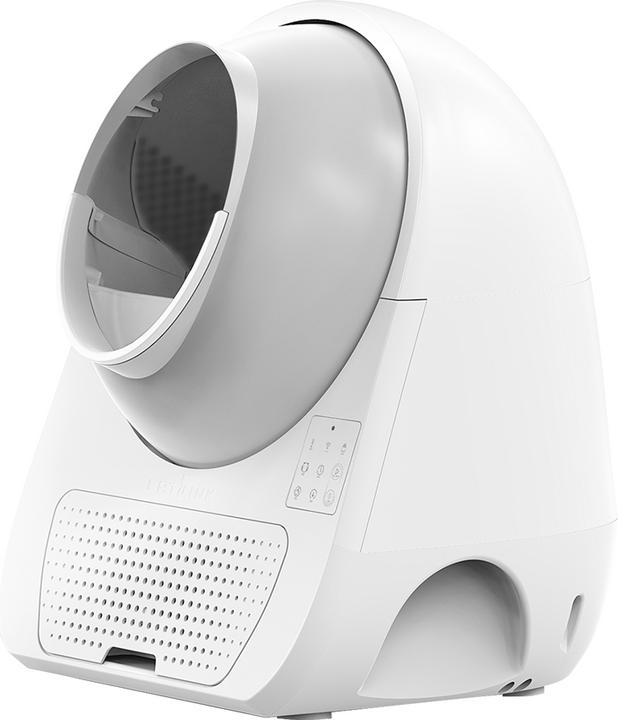
Catlink Intelligent self-cleaning cat litter tray Pro-X Luxury Version
Self-cleaning litter tray

The Catlink Scooper is a self-cleaning litter box. It promises to reduce cleaning and to up the paw pampering. But is the spaceship-like litter box really worth 750 francs?
I’m sitting at my desk when a pungent stench wafts into the room. Followed by my conspicuously inconspicuous-looking cat. «Not again,» I think to myself. Barely two hours have passed since I last cleaned the litter box – and my meeting won’t be over for another 40 minutes! Why?!
This used to be a recurring theme in my everyday life. But not since I got the Scooper self-cleaning litter box to review, manufactured by Chinese company Catlink. It promises to be the solution to situations like the one I’ve often found myself in. But does it really work?

Catlink Intelligent self-cleaning cat litter tray Pro-X Luxury Version
Self-cleaning litter tray
Disclaimer: I’m not part of our independent Editorial Team. My job is to make sure you’ve got the widest and best selection of drinks and sports nutrition in our store. Here’s the thing: self-cleaning litter boxes are one of the fastest growing categories in our online shop. And because there aren’t many cat owners on the Editorial Team, my workmate Tanja Schütz (responsible for the purchasing and marketing of food and beverages) and I were able to step in and test two self-cleaning litter boxes. You can read Tanja’s review here.
I reviewed the Catlink Scooper with the help of my girlfriend. Our testing crew: house cats Zelda (4 kilogrammes) and Leia (4.2 kilogrammes).
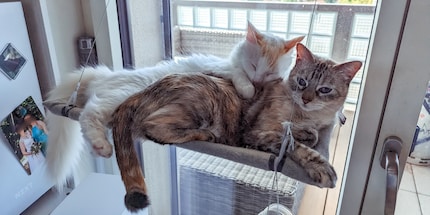
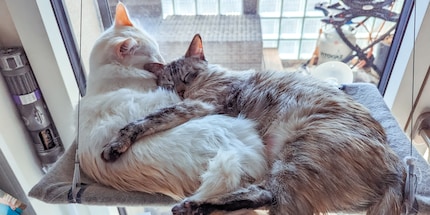
We live in a 60-square metre one-room apartment with a large balcony. Being on the seventh floor, we unfortunately can’t give our cats free access to the outdoors. They share the litter box we keep in the bathroom. We’d tried the recommended double litter box set-up, but our mousers refused to use the additional box.
The Scooper is big. Very big. It measures 72.5 centimetres in height, 59 centimetres in width and 60 centimetres in depth. It seems to be made entirely of plastic, but feels sturdy. The floor inside the globe is made of a kind of flexible silicone with a fill line for the cat litter. If you ask me, the maximum amount of litter it can take is quite small.
Setting up the toilet is quick. Putting it into operation, on the other hand, not so much. As with almost all electrical devices these days, the Scooper is coupled with an app. It’s called Catlink, like the company. Yippie. After launching the app, you have to enter your phone number. What for? Beats me. I’m certainly not expecting any emergency calls from my cat while it’s doing its business. Once your account has been created, the app connects to your home Wi-Fi – without it, it won’t work. And you can only connect to your Wi-Fi network if you grant the app access to your location. Hello, data collection!

Fortunately, the basic functions – that is, the auto-cleaning cycle and emptying the globe for manual cleaning – work without the app. However, I’d steer clear of purchasing this litter box if you don’t want to use the app. Why? Because the most important setting – the auto-cleaning delay after your cat uses the litter box – is only available in the app. Before finding this setting, I had to deep-clean the Scooper manually a few times after my cats’ too-fresh droppings wound up smeared against the wall of the globe. You can imagine how much fun that was.

So, I set the app to wait ten minutes between use and auto-cleaning cycle. This allows my cats’ deuces to dry out a bit and the litter to do its work. Once you’ve checked off this setting, you can safely delete the app – unless you insist on having a daily rundown of your cats’ use of the litter box. I, for one, don’t. Besides, the data is probably stored on some server somewhere. Sure, we already share our data with dozens of providers and giants on the internet. It may seem a bit arbitrary to draw the line here of all places. But I figure that for anyone who’s data-protection minded, it’s good to know that the Scooper’s basic functions do also work without the app.
The app only works over a 2.4 GHz network. If you’re only running 5 GHz, you won’t be able to connect. What’s more, the name of your Wi-Fi must not contain any Chinese characters (kind of funny given the company is Chinese), special characters or spaces. The impression the Catlink apps gives off is anything but trustworthy, but for testing purposes, I’m giving it a go regardless.

I start off by entering the weight of my cats. That way, the litter box can track which cat is using it. This should help can openers to detect any irregularities and thus possible health problems at an early stage. Since my cats are about the same weight, this feature has proved quite unreliable. Alternatively, you can opt for smart tag collars from the same brand. Those can also be used to track eating and drinking habits – most likely offering even more data for market research.
If you ask me, a more useful feature is that the app notifies you when a cat has been in the litter box, how often the cleaning cycle has taken place, and whether there’s enough litter left. Overall, I found the app to be rather cumbersome. On the one hand, it’s poorly programmed and anything but intuitive. Configuring it takes unnecessarily long and is more complicated than the assembly instructions for the rack next to the litter box.
All in all, the app is essentially a data leech – and not a particularly user-friendly one at that.
Let’s move on to the Catlink Scooper’s supreme discipline: self-cleaning. Unlike a traditional 50-franc plastic litter box, the promise is you won’t have to dig around in it every day to keep it clean. But how exactly does it work?
Well, the litter box is shaped like a globe. Below it is the waste drawer, which I line with the well-fitting included plastic bags. At just under 8 francs per roll, they’re not cheap. You get three rolls of 20 bags each included in the scope of delivery of the Scooper. With my two cats, one roll lasts about two months.
During cleaning, the globe rotates 180 degrees. This causes the clumped litter to pass through a hole in the globe’s wall into the drawer, while the remaining sand slides through a sieve into a kind of retention compartment. Afterwards, the globe rotates back, releases the remaining litter and levels it out. This actually works well. All I have to do is switch out the waster bag about every two to three days. That’s it. No more poking around in the litter box with a scoop! In fact, I’ve forgotten all about how annoying the app was – that’s how liberating this litter box is.
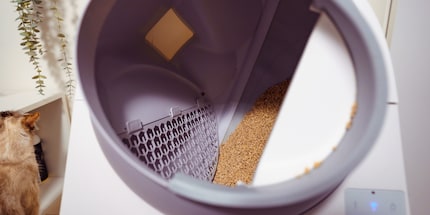
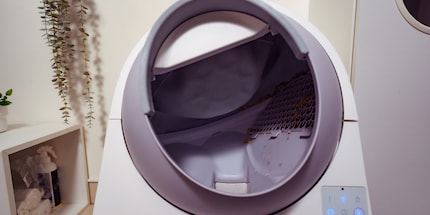
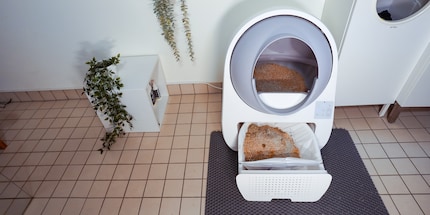
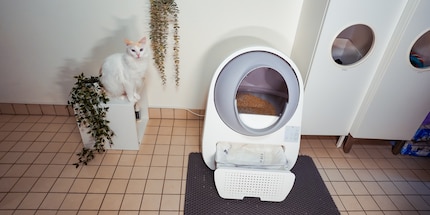
The litter box detects whether a cat is currently in it or not; as long as it’s occupied, the self-cleaning cycle won’t start.
The instructions state that wood-based pellets aren’t suitable for use with the Catlink Scooper. Unfortunate, as that’s the kind of litter our cats have used and accepted so far. As you may know, getting a cat used to anything new can prove quite a feat. So, my girlfriend and I remained stubborn at first and tried using our usual litter in the Catlink Scooper.
Spoiler alert: it didn’t work. Don’t ask.
Next, we tested several fine grain environmentally friendly alternatives to bentonite. While they work great in conventional litter boxes, not so in the Scooper. The litter sticks to the silicone surface of the toilet instead of falling into the waste drawer. Over time, the residue starts to smell disgusting. Not a good fit for people with sensitive noses like mine – let alone cats.
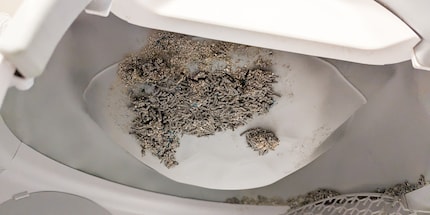

So what can you use instead? The instructions recommend a high-quality, clay-based clumping litter. So much for trying to be environmentally friendly. It’s a shame. In any case, all clay, bentonite, lime, silica sand and silicate-based litter can be used with no problems. In my test, they all performed better than the eco-friendly alternatives. These were my favourites:
In terms of odour, it makes no difference which litter you use, as the droppings end up in the waste drawer anyway. I’d like to see future versions of the litter box work with cellulose-based litter. I care a lot about sustainability, so I find it hard to reconcile that none of the compatible litter is eco-friendly. Certain types of litter can’t even be properly processed during waste incineration, which is why it ultimately ends up in the landfill. For me, this is quite a painful moral price to pay for automatic cleaning.
Every can opener will know the nasty smell that comes with having a litter box. The Catlink Scooper proves itself here with the filter that’s attached to the drawer to neutralises odours. What’s more, there’s a UV light that turns on periodically, preventing the spread of odour-causing bacteria. It also works. To me and my girlfriend, the smell is noticeable after two days when we enter the bathroom. It’s far from being an acrid, bothersome smell, but you can tell that the toilet has been used. This is a significant improvement over a traditional closed litter box. There were even times when the app notified me that the litter box was full, and I couldn’t smell anything in the living room despite the bathroom door being wide open.
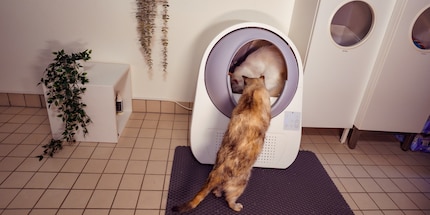
Even if one waste bag were to last longer, I’d still recommend changing it every two to three days, since cats have much more sensitive noses than humans.
Mechanically, the self-cleaning litter box does what it promises. But is it really worth a whopping 750 francs? Or is it just an unnecessary luxury that saves me some manual labour compared to a much cheaper 50-franc plastic box?
I think it’s worth the price tag. Cats have three essential needs: food (and water), social contact – and a clean litter box. Here are three scenarios that really cemented my opinion that this self-cleaning litter box is worth it:
We took several day trips to the mountains last year, and even spent the odd night away, leaving our cats to their own devices. Before having the Catlink Scooper, a guilty conscience would always start plaguing us after about eight to twelve hours of being away. And we’d be welcomed home by a stinging stench wafting from the bathroom. Side note: we like to hide dry food around the apartment to keep the cats fed and occupied while we’re away. An [automatic feeder](/search?q=automatic feeder) would also work. But I prefer to give them a game of hide-and-seek. With the self-cleaning litter box, we can now go out for 16 to 24 hours without any problems and without having to find someone to look after our cats.
Last December, my partner and I were both sick at the same time. We spent several days just lying in bed. Any normal litter box would have been filled to the brim. For the self-cleaning Scooper, it was no problem. This may sound silly, but not having to get up to clean the litter box felt like a godsend in our sickly state!
Even cats need to let their owners staff go on vacation sometimes. This is where spare can openers – also known as friends and neighbours – often step in. With a litter box that cleans itself automatically and only needs a bag change every two to three days, the most unpleasant part is reduced to a minimum (along with our guilty conscience when asking for help). In fact, if not otherwise possible, even one visit a day would be enough to keep our cats content. This has made finding a cat sitter way easier.
750 francs is a lot – more than ten times what you’d pay for a normal litter box. But it’s a big relief in everyday life. Less effort, fewer unpleasant odours and easier emptying of used litter. And thanks to the bacteria-killing UV light inside, the Scooper is more hygienic than a normal litter box.
We can’t return the automatic litter box to the manufacturer for hygienic reasons, anyways. But my partner and I agree that we couldn’t imagine not having it around anymore, so it’s a worthwhile investment. And our fur babies have accepted it, too. Our verdict? Worth the price!
On the other hand, Catlink could have left out the app. It’s poorly developed, and knowing when and for how long my cats use the litter box just isn’t worth all the data (especially my phone number) that I have to provide in the Chinese app.
From Naboo to Dominaria - I feel right at home in the fantasy worlds from Star Wars to Magic the Gathering. That's why it wasn't difficult for me to choose the names of my cats. So Zelda and Leia enrich my life. In the Galaxus galaxy, I find the most protein-rich sports food, the freshest beer and the most exclusive spirits. When I'm not DIY-ing, you'll find me in my spare time on the volleyball court, in the mountains, or playing board or card games.